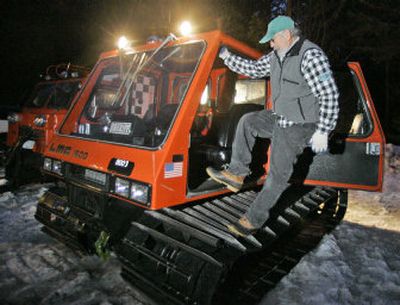Search for climbers turns to technology

COOPER SPUR, Ore. – There was no sign of three missing climbers on wind-swept Mount Hood as a third day of searching ended Wednesday with more bad weather expected in coming days.
Rescue crews were still unable to get past 7,000 feet – thousands of feet below the summit and the approximate location of one climber, whose cell phone had fallen silent after providing a signal for tracking.
FBI officials also arrived on Wednesday to help with the search, the Oregonian newspaper reports, because of their expertise in cell phone tracking.
Texas climber Kelly James used the phone Sunday to tell family members his party of three was in trouble and that two had left the summit area for help.
Rescue workers and T-Mobile officials said Wednesday that the phone had initiated a call at 7:20 a.m. Monday that didn’t go through.
On Tuesday, the phone stopped responding to the signals, or “pings,” that technicians had been sending in hopes of raising a response and fixing James’ location, they said.
Searchers on Wednesday said stormy weather would keep them from getting higher than about 7,000 feet on the mountain that reaches 11,239 feet.
A Nevada Air National Guard C-130 equipped with heat-sensing devices flew over the mountain but had to turn back after 15 minutes because the turbulence was so bad, said Chief Deputy Jerry Brown of the Hood River County Sheriff’s Office.
The Nevada air crew plans to make another run early this morning , and two Army Chinook helicopters from Fort Lewis, Wash., are expected to arrive to assist rescue teams, Brown said.
Although rescue teams were on standby for a blitz of the summit if the weather broke, the forecast for the mountain suggested they may not have a chance until the weekend, when the wind and snow are expected to abate – and daytime temperatures above 10,000 feet to drop below zero.
Two high-tech enterprises from Colorado, one using thermal-sensing drones and the other communications gear to home in on the cell phone, offered help in finding James, 48, of Dallas, his longtime climbing partner, Brian Hall, 37, of Dallas, and Jerry “Nikko” Cooke, 36, of Brooklyn, N.Y.
The three set out for the summit a week ago Wednesday but did not return on schedule. They took a challenging route, with slopes of 50 or 60 degrees and sheer walls of ice, a dangerous climb even in good weather.
Search and rescue teams searched lower canyons Wednesday on the chance that Hall and Cooke had gotten down that far. They also escorted personnel from the two companies to the Cloud Cap staging area, which is at about 6,000 feet.
One, Aracar of Morrison, Colo., hoped to send up three drones, one-pound plastic planes with propellers powered by a battery pack the size of a pack of cigarettes, said John Blitch, head of the nonprofit.
They were equipped with thermal imaging devices and would fly 300 feet to 500 feet above the surface of the mountain in search of the heat of a climber’s body, he said.
Winds prevented launching the drones but the company hopes to try again today.
The other company, Iomax of Denver, described as a wireless and data network security company, hoped to use signals gear to pinpoint James’ location, searchers said.
Although the cell phone hasn’t responded to signals in the last 24 hours, Iomax officials offered the hope that they could pick up the faintest of signals, said Hood River County Sheriff Joseph Wampler.
T-Mobile spokesman Peter Dobrow said information from the pings had given technicians a location for James at about 11,000 feet, just below the summit, with confidence that the phone was within a quarter mile. Search officials hoped Iomax could narrow that range.
The weather that held back searchers wasn’t expected to improve much and will likely get worse Friday, said meteorologist Bill Schneider of the National Weather Service in Portland.
This afternoon and Friday, he said, the biggest storm of the week will likely engulf Mount Hood, with sustained winds at higher elevations of 90 mph, gusts to 100 mph.
By Friday afternoon, the wind and snow will abate, Schneider said, but it will start to turn colder, and by Saturday daytime temperatures are expected to drop below zero at 10,000 feet.